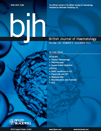Cumulative flying time and risk of venous thromboembolism
Summary
The risk of venous thromboembolism (VTE) associated with cumulative flying time remains uncertain. In a case–control study in general practices throughout the UK, participants comprised 550 VTE cases identified from practice records and 1971 age- and gender-matched controls. Participants returned identical questionnaires asking for information including air travel details. Compared to not flying, cumulative flying time >12 h within the previous 4 weeks was associated with a threefold increase in the risk of VTE [odds ratio (OR) 2·75, 95% confidence interval (CI), 1·44–5·28]. Those who had flown >4 h in a single leg in the previous 4 weeks had twice the risk of VTE (OR 2·20, 95% CI, 1·29–3·73). These risks were no longer evident by 12 weeks and were similar to those of day-case or minor surgery (OR 5·35, 95% CI, 2·15–13·33). Equivalent risks for moderate and high-risk surgery were over 30-fold (OR 36·57, 95% CI, 13·05–102·52) and 140-fold (OR 141·71, 95% CI, 19·38–1036·01) respectively. The temporary nature of the association of cumulative and long-haul air travel with VTE suggests a causal relationship. The risks of VTE in those with a higher baseline risk due to surgery, previous VTE or obesity are further increased by air travel.




